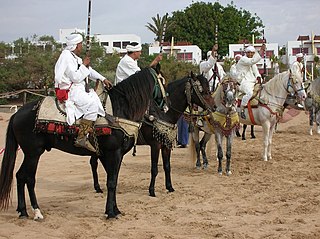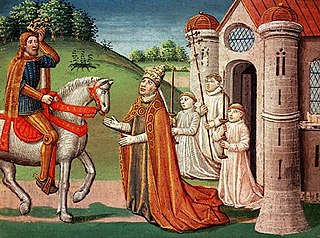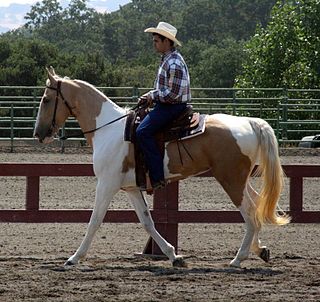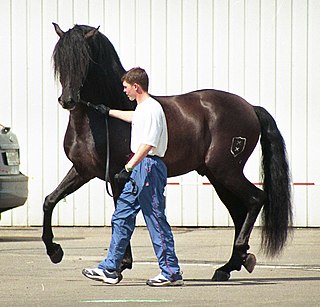
The Peruvian Horse is a breed of light saddle horse known for its smooth ride. It is distinguished by a natural, four-beat, lateral gait called the paso llano. This breed is protected by the Peruvian government through Decree number 25919 of Peru enacted on November 28, 1992, and has been declared a Cultural Heritage of the Nation by the National Institute of Culture (INC). Due to the isolation suffered for about 400 years and the selection made by their breeders, this breed is very particular in their body proportions and an ambling gait or "paso llano" that is characteristic. It is typical of the northern Peruvian regions of the country from which it originated. Trujillo city is considered the cradle of typical Peruvian Horses.

The Paso Fino is a naturally gaited light horse breed dating back to horses imported to the Caribbean from Spain. Pasos are prized for their smooth, natural, four-beat, lateral ambling gait; they are used in many disciplines, but are especially popular for trail riding. In the United States two main groups of horses are popularly called "Paso Fino": One, also known as the Paso Fino Puro Puertorriqueño, originated in Puerto Rico. The other, often called the Colombian Paso Fino or Colombian Criollo Horse, developed in Colombia. Though from similar Spanish ancestors, the two groups developed independently of one another in their home nations.

The Lipizzan or Lipizzaner is a European breed of riding horse developed in the Habsburg Empire in the sixteenth century. It is of Baroque type, and is powerful, slow to mature and long-lived; the coat is usually gray.

A palfrey is a type of horse that was highly valued as a riding horse in the Middle Ages. It was a lighter-weight horse, usually a smooth gaited one that could amble, suitable for riding over long distances. Palfreys were not a specific breed as horse breeds are understood today.

Colonial Spanish horse is a term for a group of horse breed and feral populations descended from the original Iberian horse stock brought from Spain to the Americas. The ancestral type from which these horses descend was a product of the horse populations that blended between the Iberian horse and the North African Barb. The term encompasses many strains or breeds now found primarily in North America. The status of the Colonial Spanish horse is considered threatened overall with seven individual strains specifically identified. The horses are registered by several entities.

The Barb or Berber horse is a North African breed of riding horse with great hardiness and stamina. It is closely associated with the Berber or Amazigh peoples of the Maghreb. It has influenced a number of modern breeds, including many in northern and western Africa.

The Lusitano, also known as the Pure Blood Lusitano or PSL, is a Portuguese horse breed. Horses were known to be present on the Iberian Peninsula as far back as 20,000 BC, and by 800 BC the region was renowned for its war horses. The fame of the horses from Lusitania goes back to the Roman Age, which attributed its speed to the influence of the West wind, who was considered capable of fertilizing the mares. When the Muslims invaded Iberia in 711 AD, they brought Arabian horses with them that were crossed with the native horses, developing a horse that became useful for war, dressage and bull fighting. The Portuguese horse was named the Lusitano, after the word Lusitania, the ancient Roman name for the region that modern Portugal occupies. There are four main breed lineages within the breed today, and characteristics differ slightly between each line.

The Spanish Mustang is an American horse breed descended from horses brought from Spain during the early conquest of the Americas. They are classified within the larger grouping of the Colonial Spanish horse, a type that today is rare in Spain. By the early 20th century, most of the once-vast herds of mustangs that had descended from the Spanish horses had been greatly reduced in size. Seeing that these horses were on the brink of extinction, some horseman began making efforts to find and preserve the remaining "Spanish Mustangs" drawing stock from feral and Native American herds, as well as ranch stock. The breed was one of the first to be part of a concerted preservation effort for horses of Spanish phenotype, and a breed registry was founded in 1957.

An ambling gait or amble is any of several four-beat intermediate horse gaits, all of which are faster than a walk but usually slower than a canter and always slower than a gallop. Horses that amble are sometimes referred to as "gaited", particularly in the United States. Ambling gaits are smoother for a rider than either the two-beat trot or pace and most can be sustained for relatively long periods, making them particularly desirable for trail riding and other tasks where a rider must spend long periods in the saddle. Historically, horses able to amble were highly desired for riding long distances on poor roads. Once roads improved and carriage travel became popular, their use declined in Europe but continued in popularity in the Americas, particularly in areas where plantation agriculture was practiced and the inspection of fields and crops necessitated long daily rides.

The Florida Cracker Horse is a critically endangered horse breed from the state of Florida in the United States. It is genetically and physically similar to many other Spanish-style horses, especially those from the Spanish Colonial horse group, including the Banker horse of North Carolina, and the Carolina Marsh Tacky of South Carolina.

Horses in the Middle Ages differed in size, build and breed from the modern horse, and were, on average, smaller. They were also more central to society than their modern counterparts, being essential for war, agriculture, and transport.

The term baroque horse describes a group of horse breeds, usually descended from and retaining the distinctive characteristics of a particular type of horse that rose to prominence in Europe during the Baroque era, after significant development throughout the Middle Ages. It describes the type of agile but strong-bodied descendants of horses in the Middle Ages such as the destrier. Specific ancestors of this type include the Neapolitan horse, and the Iberian horse of Barb ancestry known in the Middle Ages as the Spanish Jennet. They are characterized by powerful hindquarters, a muscular, arched neck, a straight or slightly convex profile, and usually a full, thick mane and tail. These horses are particularly well suited for the haute ecole discipline of classical dressage.

The Spotted Saddle Horse is a horse breed from the United States that was developed by crossing Spanish-American type gaited pinto ponies with gaited horse breeds, such as the Tennessee Walking Horse. The result was a colorful, smooth-gaited horse, used in the show ring and for pleasure and trail riding. Two registries have been created for the breed, one in 1979 and the other in 1985. The two have similar registration requirements, although one has an open stud book and the other is slightly more strict with regard to parentage requirements, having a semi-closed stud book. The Spotted Saddle Horse is a light riding horse, always pinto in color. Solid-colored foals from registered parents may be registered for identification purposes, so their pinto-colored foals have documented parentage. They always perform an ambling gait, rather than a trot, in addition to the gaits of walk and canter, performed by all breeds.

The Neapolitan Horse, Italian: (Cavallo) Napoletano, Neapolitano or Napolitano, is a horse breed that originated in the plains between Naples and Caserta, in the Campania region of Italy, but which may have been bred throughout the Kingdom of Naples. The Neapolitan horse was frequently mentioned in literature from the 16th to the 19th centuries, and is noted for its quality. Corte wrote in 1562: "in Italy the horses of the Kingdom of Naples are greatly esteemed; [there] many fine coursers are born ... suitable for use in war and in the manège and for every service that the rider may require". The decline of the breed was noted in the early 20th century by Mascheroni (1903) and Fogliata (1908). Some sources state that by 1950, the original Neapolitan horse was deemed extinct, but its lines were incorporated into other breeds, most notably the Lipizzaner. An attempt to recreate this breed resulted in the modern breed called Napolitano.

The Spanish Jennet Horse is a modern American horse breed. It is gaited, with either pinto or leopard spotting; its conformation supposedly resembles that of the historical Spanish Jennet, a riding horse of Renaissance Europe, now absorbed into the Pura Raza Española.

The Andalusian, also known as the Pure Spanish Horse or PRE, is a horse breed from the Iberian Peninsula, where its ancestors have lived for thousands of years. The Andalusian has been recognized as a distinct breed since the 15th century, and its conformation has changed very little over the centuries. Throughout its history, it has been known for its prowess as a war horse, and was prized by the nobility. The breed was used as a tool of diplomacy by the Spanish government, and kings across Europe rode and owned Spanish horses. During the 19th century, warfare, disease and crossbreeding reduced herd numbers dramatically, and despite some recovery in the late 19th century, the trend continued into the early 20th century. Exports of Andalusians from Spain were restricted until the 1960s, but the breed has since spread throughout the world, despite their low population. In 2010, there were more than 185,000 registered Andalusians worldwide.

This is a basic glossary of equestrian terms that includes both technical terminology and jargon developed over the centuries for horses and other equidae, as well as various horse-related concepts. Where noted, some terms are used only in American English (US), only in British English (UK), or are regional to a particular part of the world, such as Australia (AU).
The Siciliano indigeno is a breed of horse from Sicily resulting for the admixture of Oriental and African Horses, with the contribution of African Horses being the greatest. Spanish and Norman horses also contributed to the formation of the Breed
The American Indian Horse is defined by its breed registry as a horse that may carry the ancestry of the Spanish Barb, Arabian, Mustang, or "Foundation" Appaloosa. It is the descendant of horses originally brought to the Americas by the Spanish and obtained by Native American people. The registry was created in 1961 when some breeders of Colonial Spanish Horse bloodlines considered the Spanish Mustang breeders to be departing from the original "Indian horse" phenotype. The organization was started "for the purpose of collecting, recording and preserving the pedigrees of American Indian Horses." The registry also allows the "hybrids [sic] and descendants" of the original Spanish Colonial Horse to be registered. Horses registered with other breed registries to be double-registered with this organization if the horses meet the conformation requirements.

















